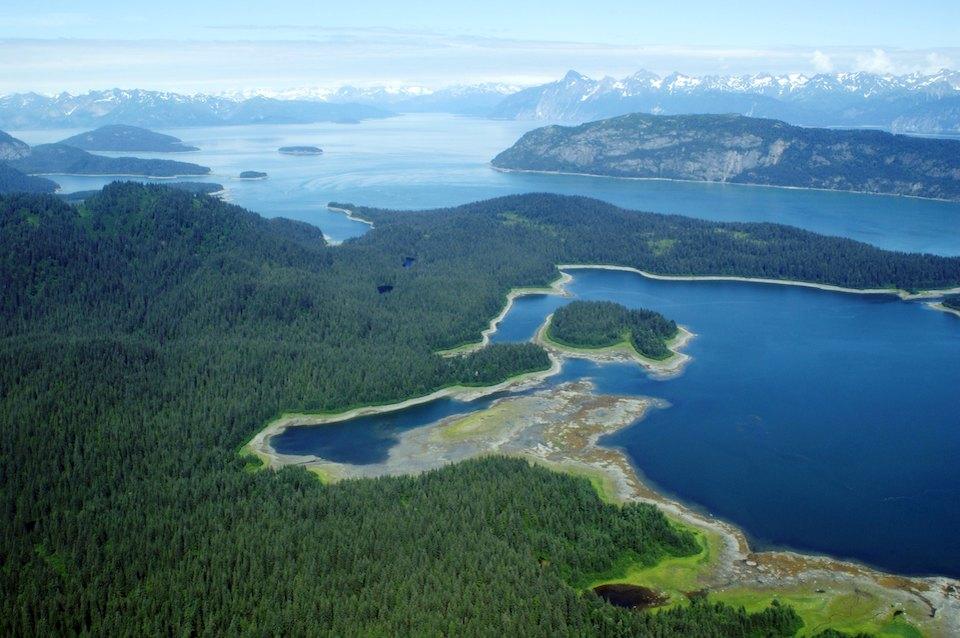
Berg Bay in Glacier Bay National Park and Preserve/NPS
A 150-acre cultural site has been added to Glacier Bay National Park and Preserve in southeast Alaska that will be managed in collaboration with the Hoonah Indian Association, a federally recognized tribal government, through a unique conservation easement.
The newly acquired property, which sits at the head of Berg Bay, is a sacred site for the Huna Tlingit. The land will provide opportunities for tribal members to engage in traditional cultural practices and will support public access to fishing, hiking and camping opportunities thanks to funding from the Land and Water Conservation Fund and other sources.
The 150-acre Berg Bay property faced potential development as one of few parcels left within the national park boundary not in federal ownership. When the property was listed for sale in 2018, both the Hoonah Indian Association and the National Park Service prioritized federal acquisition of the property to protect its cultural values as well as the 2,000 feet of highly visible and sensitive shoreline, upland forested habitat and productive river it encompasses. The Berg River, which passes through the property, supports runs of sockeye, Coho and pink salmon, and surrounding lands are important habitat for black and brown bears, moose, wolves, bald eagles and migrating waterfowl.
Recognizing its importance to the Huna Tlingit and its ecological significance, NPS worked with the Hoonah Indian Association, The Conservation Fund, and National Park Foundation to find a conservation solution for the land.
“We knew that protecting the cultural and natural resource values associated with this special place required a unique solution,” said Philip Hooge, Glacier Bay National Park and Preserve superintendent. “We found that solution by partnering with our tribal neighbors and the conservation community. We share common stewardship goals for Glacier Bay, a place that is homeland to some, and a source of renewal for many others.”
The property encompasses a large portion of Chookanhéeni [Grassy River], site of an ancestral Tlingit village and the place of origin of the Chookaneidí Clan. It is one of the tribe’s most revered sites and is eligible for listing on the National Register of Historic Places as a Traditional Cultural Property. Generations of Huna Tlingit hunted, fished and gathered on the surrounding lands and waters, and tribal members retain strong ties to the area.
“The identity of the Huna Tlingit depends on maintaining meaningful connections with Glacier Bay Homeland. Bringing our youth to sacred places like Chookanhéeni to harvest fish, to learn our stories, to be part of our history, and to walk with ancestors—that is what sustains our culture. We cannot and must not let that go,” said Bob Starbard, tribal administrator for the Hoonah Indian Association
“The challenge here was to find a way to protect the property while maintaining tribal member access to an important cultural site inside Glacier Bay,” said Brad Meiklejohn, Alaska senior representative at The Conservation Fund. “Beyond the conservation value and sheer wildness of Berg Bay, its land and waters are essential to wildlife and cherished culturally and recreationally. This partnership allowed us to support the cultural heritage of the Huna Tlingit, support our recreation economy and keep Alaska wild.”
“The National Park Foundation is honored to partner with the Huna Tlingit, the National Park Service, The Conservation Fund, and Alaska’s congressional delegation to preserve the Berg Bay property,” said Will Shafroth, president and CEO of the Foundation. “This collective effort is rejuvenating the land itself, the spiritual connections to it, and the economic benefits it provides to local communities.”
The Conservation Fund purchased the land with support from the National Park Foundation and additional private contributions in 2018. The Park Service acquired the land this September using funds from the federal Land and Water Conservation Fund.
Through a unique conservation easement, the Hoonah Indian Association retains certain traditional rights of access and can build and maintain the simple structures required to support traditional uses, including a smokehouse, food cache, and tent platforms to support youth culture camps. The land will serve as an ideal location for culture camps, cultural fishery programs, and other traditional activities, providing opportunities to maintain and strengthen the connection between the Huna Tlingit and their ancestral Glacier Bay homeland.
Located just 15 miles from Bartlett Cove where the Xunaa Shuká Hít (Huna Ancestors’ House) stands, the Hoonah Indian Association, and Park Service envision cultural programs that link activities at the Tribal House to camps and other traditional gatherings at Chookanhéeni.


 Support Essential Coverage of Essential Places
Support Essential Coverage of Essential Places






